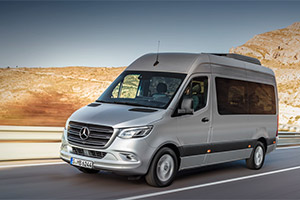
The mid-1990s was a pretty special time where a little sense of security and predictability was always welcome. It was then, or rather in 1995, that Daimler AG released the first generation of the Sprinter. A model that has become a hit with many specialized transport companies, traders, tour operators, campers and many others. What is the secret to Sprinter's success? To answer this question, it would be good to dig into the history of this type of car at Mercedes.
A story that began back in 1955
In 1955, Mercedes introduced the L 319 at the IAA. This is a truck of the category up to 7.5 tons, which is not a modified version of an already known car or cargo platform, but a completely new development. Its design is simplified, and that is why it is very flexible. In the L 319, the engine is mounted under the high cab, so there is no need for a protruding front end. The body is self-supporting, the suspension is with rigid axles and leaf springs, the brake system with booster is a first for a Mercedes model of that time, the same goes for the lockable steering column. It was during this period that crash testing came into vogue, so the L 319 was immediately subjected to this type of test: the idea of locating the cab behind the front axle turned out to be a plus for safety.
Although the L 319 is in the light-duty category, it uses an engine familiar from the brand's passenger car lineup of the time, borrowed from the 180 D. With the base diesel engine, the Sprinter's progenitor has a total of 43 horsepower. The maximum allowable weight of the model reaches 4.2 tons. As you might guess, the combination of these indicators leads to modest dynamics, to put it mildly. Still, the four-cylinder prechamber diesel engine is quite interesting in itself, because it works not only in Mercedes models, but also in fire pumps, ships, forklifts, power plants, tractors and, last but not least, in Spanish taxis of the 80s based on Fiat 124.
In 1967, the L 319 was replaced by the L 309, also known as the "T2". The new model is produced in Düsseldorf. In the second generation, safety and comfort play an important role. The latter is good, because the creators of the model are aware that the drivers of such cars spend a lot of time with them, and it is not good to come out beaten after a long transition.
In addition, the transporter gets an improved ergonomic cabin concept, with clearly visible controls, easily accessible functional elements and generous glazing for optimal visibility in all directions. The steering wheel is now power-assisted, which also improves driving comfort. The cargo volume has also been increased; Both cargo and passenger versions are available.
The well-known "T1" left the factory in Bremen and entered the market in 1977 - this is an important step in the development of Mercedes light truck models. The model has disc brakes in front, ABS, air conditioning and heated side mirrors will also appear later. The model with the iconic muzzle is becoming a permanent landmark in the landscape of countless countries around the world. The T1 is still produced under an official license from Force India under the name "Shaktiman" for the Indian market. But let's not get too carried away - after all, this material is dedicated to the name Sprinter, which appeared 25 years ago, right ?.
Sprinter was born in 1995
And so we come to the cherished year 1995. Mercedes creates a special division for low-tonnage models. The new model is badged "T1N" and badged Sprinter and now comes with all-wheel disc brakes, ABS and a driver's airbag as standard, and a second airbag as an option. The Sprinter's cabin noise isolation is now near passenger car level, and after 1.3 million units sold, it looks like the brand with the three-pointed star has found the right recipe for such a car. Performance is constantly improving, as is design. Common rail diesels perform well and have low fuel consumption, and after the second facelift, ESP comes as standard.
However, modern help systems only appeared with the new edition of NCV 3, which debuted in 2006. Automatic high beam activation, crosswind assistant and parking sensors are only part of this generation's range. The ESP system adapts its operation depending on the load, determines the position of the load and changes its settings depending on the current situation. The model can be ordered with a different wheelbase and body height. Sprinter allows many conversions and is available in versions such as VIP shuttle and dump truck. In those years, the "moose test" was still a sensitive topic for Mercedes - so it's nice to note that after 2006, the Sprinter successfully handled this exercise - with an attached load.
The third generation Sprinter was released in 2018 under the designation VS30 and rolled off the assembly lines of the Düsseldorf plant. There is also production in the USA, Argentina, China and Russia. The floor of the cargo compartment was lowered by 80 millimeters. In its smaller versions, the Sprinter is now also available in front-wheel drive variants. Along with modern assistance systems, the MBUX infotainment system comes from the brand's passenger car line. The new Sprinter also boasts an all-electric variant that can travel around 150 kilometers on a single charge. At the same time, Mercedes remains true to its strategy dating back to 1955 - to keep up with the times and often one step ahead of others.




